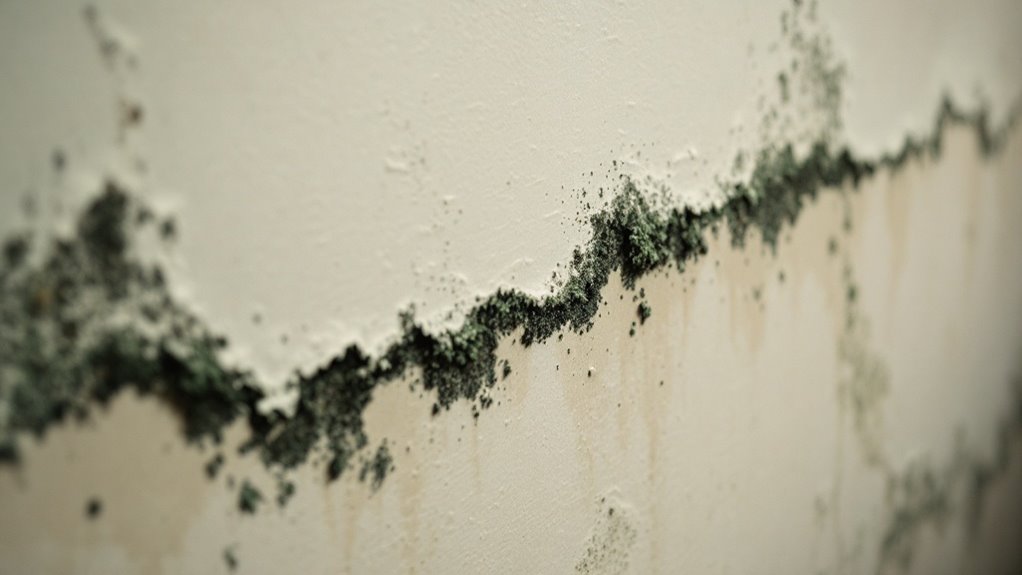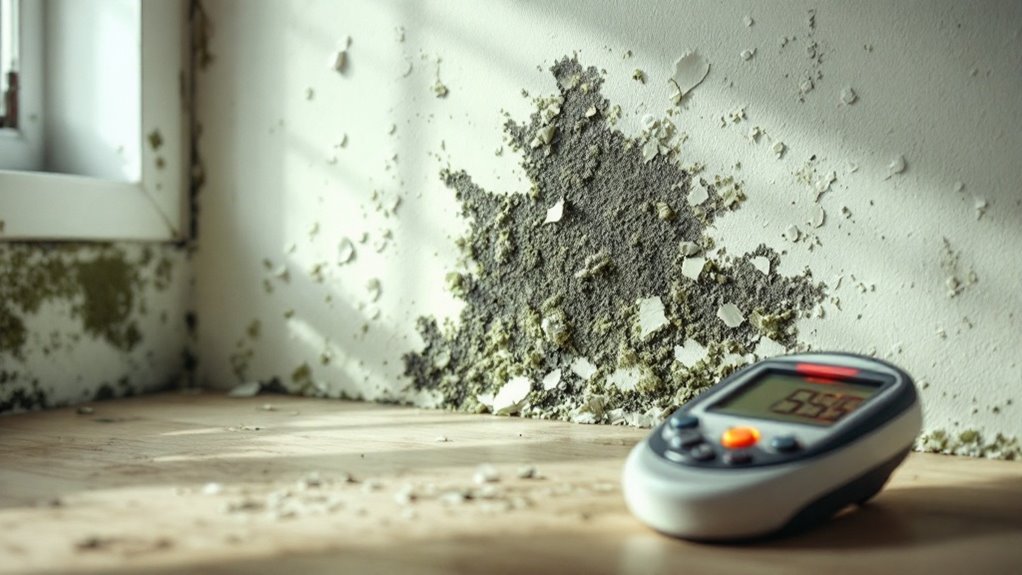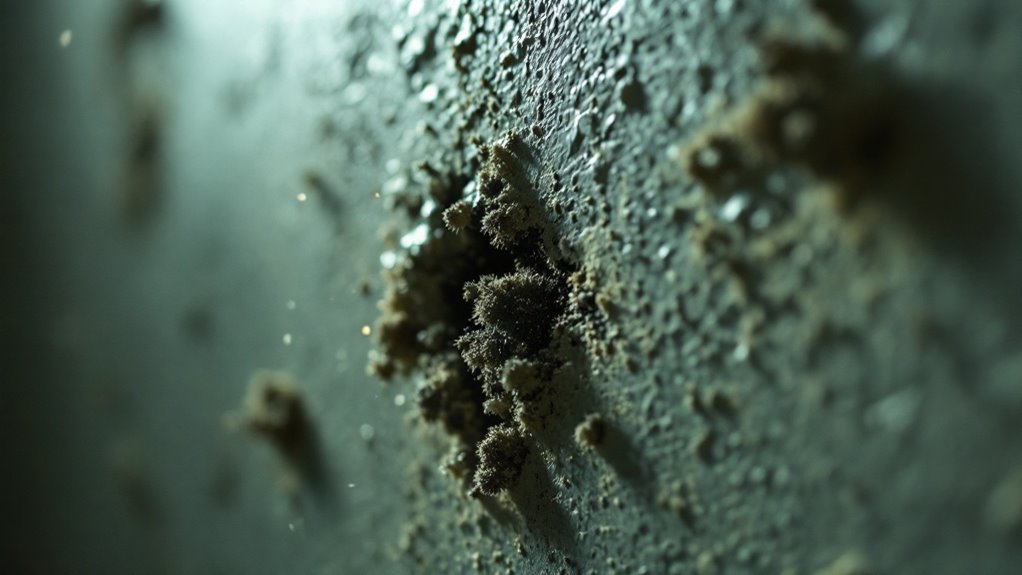If you’ve recently experienced water damage, you might wonder if mold is lurking behind your walls. Mold can develop quickly in damp spaces, often going unnoticed until it presents serious issues. You may notice musty odors or see water stains that hint at moisture problems. Ignoring these signs can lead to health risks and costly repairs. What steps should you take next to guarantee your home stays safe and mold-free?
Key Takeaways
- Mold thrives in moist environments, making water-damaged walls a prime location for growth if not addressed promptly.
- Visible water stains or musty odors often indicate mold presence behind walls due to trapped moisture.
- Inspect the area for signs of leaks, such as peeling paint or discoloration, which may suggest mold growth behind walls.
- Using moisture meters can help detect hidden dampness in walls, indicating potential mold issues.
- Consider professional assessment and remediation if mold is suspected behind walls to ensure thorough removal and prevention of future growth.
Understanding Mold and Its Risks

Mold is a common consequence of water damage, and understanding its risks is vital for your health and safety. When moisture seeps into walls, ceilings, or floors, it creates a perfect environment for mold growth. This fungus can release spores into the air, which you might breathe in, leading to respiratory issues, allergies, or even more severe health problems. It’s not just a nuisance; mold can damage your property and lower its value. If you notice a musty smell or visible mold, act quickly. Guarantee proper ventilation, fix leaks, and consider professional help for remediation. Being proactive can help protect your home and your well-being. Remember, the sooner you address mold, the less risk it poses to you and your family. Additionally, comprehensive mold solutions are crucial for effectively addressing existing mold while preventing future growth.
Common Causes of Water Damage
Water damage can stem from various sources, and recognizing these common causes is key to prevention. Understanding where water damage originates helps you take proactive measures. Here are three common causes:
- Leaky Pipes: Aging or damaged plumbing can lead to leaks, which often go unnoticed until significant damage occurs.
- Roof Issues: Missing shingles or damaged flashing can allow rainwater to seep into your home, causing interior damage.
- Appliance Malfunctions: Washing machines, dishwashers, and water heaters can fail, leading to unexpected leaks that flood your space. Regular inspection of pipes for signs of wear or leaks is essential to prevent these issues.
Signs of Water Damage in Your Home

You might notice visible water stains on your walls or ceiling, which can indicate a leak or water intrusion. Furthermore, if there’s a musty odor lingering in your home, it could mean moisture is trapped somewhere, encouraging mold growth. Recognizing these signs early can help you address potential water damage before it worsens. Additionally, if you experience burst pipes or severe leaks, it is crucial to contact 24 hour plumbing services to prevent extensive damage and mold proliferation.
Visible Water Stains
Visible water stains are often the first indicator of hidden damage lurking in your home. These stains can appear on ceilings, walls, or floors, signaling potential issues that need immediate attention. Here’s what to look for:
- Color Changes: Stains may appear yellow, brown, or even black, indicating moisture accumulation.
- Texture Alterations: You might notice peeling paint, bubbling wallpaper, or warped surfaces, all suggesting underlying water problems.
- Location Patterns: Stains near plumbing fixtures, windows, or roofs can point to specific sources of leakage.
If you observe any of these signs, don’t ignore them. Addressing visible water stains promptly can prevent further damage and potential mold growth in your home. Stay vigilant and take action before it escalates!
Musty Odor Presence
After noticing visible water stains, another telltale sign of water damage is the presence of a musty odor in your home. This unpleasant smell often indicates mold growth, which thrives in damp environments. If you catch a whiff of something musty, it’s essential to investigate further. Check areas near water stains, behind furniture, and in closets where moisture might linger. Mold can develop quickly, and ignoring the smell won’t make it disappear. To address the issue, you’ll need to identify the source of the moisture and address it promptly. Remember, a musty odor is not just unpleasant—it can likewise signify potential health risks for you and your family. Don’t hesitate to seek professional help if needed.
How Mold Grows and Spreads
While mold thrives in damp environments, its growth and spread can occur rapidly under the right conditions. To understand how mold proliferates, consider these key factors:
- Moisture: Mold needs a source of water. Even small leaks or high humidity can promote growth.
- Temperature: Mold prefers warm temperatures, typically between 77°F and 86°F. This range provides an ideal environment for reproduction.
- Organic Material: Mold feeds on organic materials like wood, paper, and drywall. If these materials are present and damp, mold can take hold quickly.
Once these conditions are met, mold can spread through spores, which can travel via air or physical contact. Recognizing these factors helps you understand how quickly mold can become a problem in your home.
Identifying Hidden Mold Behind Walls

Since mold often grows in hidden spaces, identifying it behind walls can be challenging yet crucial for maintaining a healthy home environment. Look for signs like water stains, musty odors, or peeling paint, as these can indicate moisture and potential mold growth. Check areas near plumbing, windows, and roofs for leaks.
| Signs of Hidden Mold | Possible Causes | Action Steps |
|---|---|---|
| Water stains | Leaking pipes | Inspect plumbing |
| Musty odors | High humidity | Use a dehumidifier |
| Peeling paint | Poor ventilation | Improve airflow |
| Warped walls | Flooding | Assess water damage |
Tools and Techniques for Detection
When it comes to detecting mold, you’ll want to start with some reliable tools and techniques. Visual inspection methods can help you spot visible signs, while moisture meters give you precise readings of damp areas. Air quality testing is likewise essential to assess the presence of mold spores in the environment.
Visual Inspection Methods
How can you effectively spot mold after water damage? Conducting a thorough visual inspection is essential. Here are three methods you can use to detect mold:
- Check for Discoloration: Look for dark spots or staining on walls, ceilings, and floors. Mold can appear black, green, or even white.
- Smell for Mustiness: A persistent musty odor is often a telltale sign of mold growth. Trust your nose; if it smells off, investigate further.
- Examine Air Vents and Ducts: Mold can thrive in hidden areas, including air vents. Look for dust buildup or unusual moisture around these spots.
Moisture Meter Usage
Visual inspections can reveal a lot about potential mold growth, but to get a clearer picture of moisture levels, using a moisture meter is a smart move. These handy tools measure the moisture content in various materials, helping you identify hidden dampness behind walls or beneath floors. To use a moisture meter effectively, start by selecting the right type—pin or pinless—depending on your needs. Press the meter’s probes into the material, or glide it along the surface for non-invasive readings. Keep an eye on the readings; anything above 15% moisture could indicate a problem. Regularly checking moisture levels can help you catch mold growth before it spreads, ensuring a healthier living environment.
Air Quality Testing
What tools and techniques can you use to test air quality after water damage? Ensuring your indoor air quality is safe is essential, especially after experiencing water damage. Here are some effective methods:
- Air Sampling Pumps: These devices collect air samples that can be analyzed for mold spores and other contaminants.
- Dust Sampling Kits: You can use kits to collect dust from surfaces. This dust can then be analyzed for mold presence and types.
- Indoor Air Quality Monitors: These electronic devices measure various air quality parameters, including humidity and particulate matter, providing real-time data on your environment.
Utilizing these tools helps you identify potential mold issues, allowing you to take timely action to protect your health and home.
Health Symptoms Associated With Mold Exposure
When you’re exposed to mold, your body might react in various ways, signaling that something’s not right. You could experience symptoms like sneezing, coughing, or a runny nose, which are common allergic reactions. Some people report skin irritation or rashes after contact with mold spores. If you have asthma or other respiratory conditions, mold exposure may worsen your symptoms, leading to wheezing and difficulty breathing. Fatigue, headaches, and even memory issues can arise, leaving you feeling foggy and drained. It’s vital to pay attention to these signs, as they can indicate a more significant problem. If you notice these symptoms, especially after water damage, it’s important to investigate further to protect your health.
Steps to Take After Discovering Mold
Upon finding mold in your home, it’s crucial to act swiftly to minimize health risks and prevent further damage. Here are the steps you should take:
- Isolate the Area: Close doors and windows to contain the mold spores, preventing them from spreading to other parts of your home.
- Protect Yourself: Wear protective gear, including gloves, goggles, and a mask, to safeguard against inhaling spores and touching contaminated surfaces.
- Assess the Damage: Identify the extent of the mold growth and the source of moisture. Document the situation for insurance purposes and consider contacting a professional if needed.
Taking these steps guarantees you’re proactive in dealing with mold, promoting a healthier living environment while reducing the risk of further complications.
Professional Mold Remediation vs. DIY Solutions
When it comes to tackling mold after water damage, you’ve got two main options: professional remediation or DIY methods. While DIY can save money, it often lacks the expertise and experience that professionals bring, not to mention the safety and health risks involved. Understanding these differences can help you make the best choice for your situation.
Expertise and Experience
How do you decide between professional mold remediation and tackling the problem yourself? It often comes down to your expertise and experience. Here are three key factors to evaluate:
- Identification: Professionals can quickly identify hidden mold sources and assess the extent of damage, whereas you may miss critical areas.
- Equipment: Mold remediation requires specialized tools and protective gear that you might not have on hand, whereas professionals come equipped for the job.
- Time and Effort: DIY solutions can be time-consuming and labor-intensive, potentially leading to frustration. Professionals can efficiently handle the task, saving you time and stress.
Ultimately, weighing your skills against the complexity of the issue will help you make the right choice for your home.
Safety and Health Risks
While you might be tempted to tackle mold removal on your own, the safety and health risks involved often make professional remediation the better choice. Mold spores can cause allergic reactions, respiratory issues, and even more serious health problems, especially for vulnerable individuals like children and the elderly. Without proper protective gear and knowledge, you could expose yourself to harmful toxins. Professionals not only have the right equipment but additionally know how to identify hidden mold and prevent its return. DIY solutions might seem cost-effective but can lead to incomplete removal and future health risks. Ultimately, investing in professional help guarantees your home is safe and free from harmful mold, protecting you and your loved ones.
Preventing Future Mold Growth in Your Home
To effectively prevent future mold growth in your home, it’s crucial to address moisture issues promptly. Here are three key steps you can take:
- Fix Leaks Immediately: Regularly inspect your plumbing, roofs, and windows. Repair any leaks as soon as you notice them to minimize water accumulation.
- Control Humidity Levels: Use dehumidifiers and air conditioners to maintain indoor humidity below 50%. Ventilate areas prone to moisture, like bathrooms and kitchens.
- Insulate Properly: Confirm your home is well-insulated. This helps prevent condensation on cold surfaces, reducing the risk of mold growth.
Conclusion
In the battle against mold, don’t let it become a silent invader lurking behind your walls. Think of your home as a fortress; you need to guard it against moisture and decay. By staying vigilant and addressing any signs of water damage swiftly, you’re not just protecting your property—you’re safeguarding your health. Don’t wait for the musty smell to signal trouble; take action now, and keep your living space fresh and safe like a well-tended garden.
